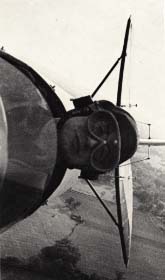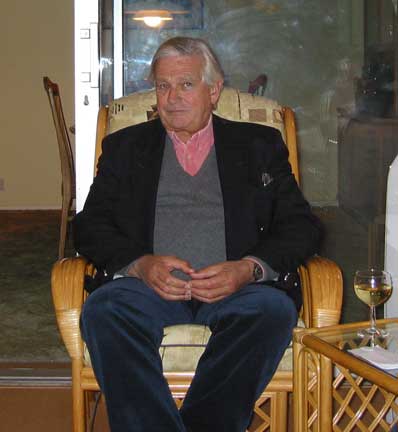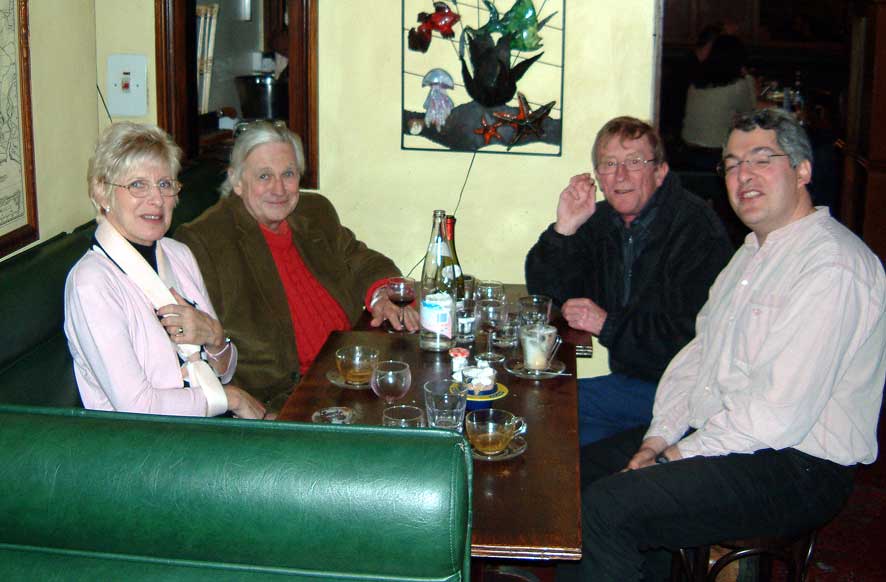James Gilbert
![]()
James Gilbert |
|
|
James Gilbert died on February 14, 2006 after a long illness. Gena has asked me to let all of James's old friends and colleagues know that a Memorial Service for him will be held on 28 April (which would have been his 71st birthday) at the Royal Air Force Church, St Clement Danes, in the Strand, London, starting Midday. Mike Jerram |

James Gilbert
|
James Gilbert is familiar to everyone in the Falco world, of course. I first learned about the Falco from an article James wrote in Air Progress and also from his book The Great Planes. There had been a few articles on Frati in Italy and France, but James was the first to write in English about Frati aircraft. Before James Gilbert's articles, the S.F. 260 and the Falco were largely confined to Italy -- a few did slip out to England and Germany -- and most painted in pastel colors. When we introduced the Falco, James wrote a flight report on an old production Falco in which he suggested Falcos should be painted red, like other "red Italian things." Now they are flown all over the world and many are painted Ferrari red. Blame it all on James Gilbert, the patron saint of Frati aircraft. I'll miss James and I enjoyed our long association from opposite sides of the Atlantic. I have always considered it to be an honor to have dealt with him. If you would like to write James's wife, Gena, please address your letters to Gena Gilbert, One Grafton Square, London SW4 ODE, England, or she would also be happy to receive emails from any of you. She's at: zzgilbert@aol.com If you would like to contribute any comments to be posted below, please email them to me. Alfred Scott |

James at London Falco party, September 2002
|
I first met James Gilbert in the late 1960s, when I joined Flying Magazine as a young editor. I was an inexperienced pilot with a license less than a year old and fewer than 100 hours. Flying believed that it was easier to turn a writer into a pilot-reporter than it was to turn a pilot into a writer. James, bless him, had the incredible advantage of being a superb player in both arenas. As well as being arguably the world’s best aviation photographer. James and I immediately were rivals. I’d come to Flying from a far larger national travel magazine and thought I was what Air Force guys would abbreviate as “sierra hotel.” James owned an E-Type Jaguar, and here I am trumping him with my Aston Martin DB4. And we were competing for the attention of the magazine’s rather quixotic Editor, Robert Parke. But James Gilbert was already the magazine’s star. He was a Brit at a time when groovy still was synonymous with the Stones, swingin’ London and Twiggy. He’d been a runner-up to the British national aerobatic championship. He was on a first-name basis with everyone from Bob Hoover to Bill Lear. He was dating a Twiggy-wispy fashion model. And he was allowed to fly our company’s Aztec whenever and wherever he wished. Aston Martin or not, I wasn’t allowed anywhere near the Piper twin unless it was the rearmost row, two tiny seats. The angriest James ever revealed himself to me came the day when I had persuaded Bob Parke that I should be allowed to use the legendary Ernest K. Gann as a contributor to a Flying annual special issue that I’d been assigned to produce, even though James had already arranged with Gann to write for a different special issue that James was editing. “Does your Aston have a stick shift?” James politely asked me that day. “Why, yes, it does,” I answered, and began to describe the niceties of my DB4’s gearbox. “Then I suggest you go out to your car and sit on it,” James said and stalked away, leaving me mumbling about gear ratios and clutch-pedal pressures. Yet James took it upon himself to coach me in the intricacies of “testing” an airplane in order to write a pilot report. The first time I tried it, flying a soon-to-be-forgotten Canadian bushplane called a Found Centennial, the Found factory pilot seemed impressed by my yoke-whacking, cross-controlling and phugoid-inducing. So if nothing else, James’s instruction looked effective. (Fortunately, the Found was a stable old clunker, for James had told me nothing about recovering from a spin or a behind-the-power-curve sink.) At the time, James Gilbert had re-invented aviation photography, which until he came along was still mired in the Hans Groenhoff tradition of super-clear, near-static shots that if nothing else showed the entire airplane wingtip-to-wingtip, no cropping, lovely clear backgrounds. Gilbert, however, gave air-to-air a whole new vocabulary. He used his telephoto lens as a probing voyeur, framing utterly unexpected, intimate, in-flight close-ups of cockpits and engines and disjointed but spectacular sections of airplanes. He panned and blurred and painted with his camera, and we all learned to look through a lens differently. I will forever remember one classic James Gilbert story, which to me encapsulates the man’s sense of humor, pride and, yes, arrogance. James and the late Richard Weeghman, another superb staffer from Flying’s golden age, were assigned as writer and photographer to produce a pilot report on a new twin-engine Dornier utility airplane. They were met on the airport ramp by a yappy young Dornier demo pilot, an American. “So,” the kid said, “either of yez ever fly a Dorn-yay before?” “No,” James quietly answered in the plummy Sloane Square accent he could summon, “but I’ve been bombed by them.” Ultimately, James and I became friends forever, and I grieve that I’ve lost him so soon. Stephen Wilkinson Steve originally wrote this for Pilot magazine as one of a number of reminiscences from Pilot contributors such as Maxi Ganza and Bernard Chabbert. |

November 2005 in London
Kaye Jerram, James, Brian Lecomber, Philip Whiteman.
|
I first became aware of the name James Gilbert soon after leaving school in the mid-1960s. An eager reader of the American Flying magazine, I was much taken by the style of both his writing and photography. At that time I earned part of my living as a weekend freelance press photographer for a local newspaper. My fare mostly comprised garden fetes and amateur soccer matches, but I took every opportunity — albeit unpaid — to indulge my passion for photographing aeroplanes, shamelessly aping James’s style. Long lenses to separate subject from background. Pulling in close for tight, telling little vignettes. And of course, those sunset shots. I submitted some of them to a little magazine called Pilot. Its then editor sent them back by return with a note saying that they “were not the kind of thing Pilot would wish to publish”. Crestfallen, I concentrated on fetes and football. Then, browsing the newsstand one day, I spotted a new name at the top of Pilot’s masthead: James Gilbert. Off went those same pictures, and one — a moody shot of a Rothman’s Stampe at dusk as I recall — filled the Contents page of the very next issue. I had no idea then that my somewhat hesitant submission would forge a working relationship — and more importantly a friendship — that would endure for more than three decades, launch me on an adventure that would transform my life (as James did unselfishly for many others) and see me serving as Pilot’s deputy editor for many of those years. When we worked together on daily news magazines at the major international airshows, ‘JG’s’ morning editorial briefing to ‘the troops’ would invariably include the admonition Keep it short! So I’ll bid a final farewell and pay tribute thus. Inspiration. Mentor. Friend. Even you couldn’t edit that, James.
Mike Jerram
mjeditorial@btopenworld.com |
|
James Gilbert was an accomplished pilot, a superlative writer and an aviation journalist who had worked with several magazines including Aeroplane in the UK and Flying in America before returning to Britain in 1970 and taking over as editor of Pilot in 1972. By 1978 James had become owner of Lernhurst Publication, the then publisher of Pilot. He sold the magazine in 2000 to the current publisher, Archant. James was an enthusiastic private pilot. He learned to fly on an RAF scholarship in a Tiger Moth in 1952. After National Service, he worked in advertising with the Blackburn Aircraft Company, then moved into aviation journalism. By 1970, the year he returned from America, he had logged over 1,200 hours piloting over 100 different types. He entered the Lockheed Trophy flying the Tiger Club Stampe and did very well... though the Stampe was by then outclassed by the Zlin monoplane. He is most associated with a 1940 Bucker Jungmeister in which he gave immaculate aerobatic displays. He was a best selling author. The World's Worst Aircraft was published in 1975 and came out in paperback. In 1977 he published The Flier's World and an anthology of aviation writing, Skywriting, came out a year later. He was also involved in the world of film, assisting in the production of the 1969 classic film Battle of Britain, and flying in the dogfight scenes in the Great War film Aces High alongside such luminaries as Neil Williams. It was James who landed the Fiesler Storch in The Eagle has Landed. You can see him walk laconically away afterwards. James will be missed by his countless friends and colleagues. He died after a long illness. Pilot Magazine |
|
|